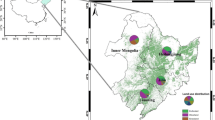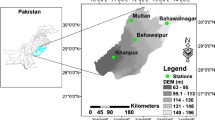Abstract
Climate change is a global environmental crisis, but there have been few studies of the effects of climate change on cereal yields on the Tibetan Plateau. We used data from meteorological stations and statistical yearbooks to assess the impacts of climate change on cereal yields in Tibet. Three types of statistical models were selected: fixed-effects model, first-difference models, and linear detrending models. We analyzed the impacts of climate change (including the minimum temperature, precipitation, growing degree days and solar radiation) on cereal yields in Tibet from 1993 to 2017 at the county, prefecture-level city, and autonomous region scales. The results showed that the sensitivity of cereal yields in Tibet to temperature (minimum temperature and growing degree days) was greater than their sensitivity to precipitation and solar radiation. The joint impacts of climate variables were positive, but the sensitivity and significance varied in different regions. The impacts of minimum temperature, precipitation, and solar radiation were positive in all cities, apart from the negative impacts of growing degree days on cereal yields in Lhasa. The impacts of climate trends on cereal yields in Tibet were positive and the results were in the range of 1.5%–4.8%. Among the three types of model, the fixed-effects model was the most robust and the linear detrending model performed better than the first-difference model. The robustness of the first-difference model decreased after adding the interaction terms between different climate variables. Our findings will help in implementing more spatially targeted agricultural adaptations to cope with the impacts of climate change on the agro-ecosystem of the Tibetan Plateau.
Similar content being viewed by others
References
Du J, Hu J, Sonam N, 2005. Climatic change of agriculture critical temperature over Tibetan Plateau from 1971 to 2000. Acta Geographica Sinica, 60(2): 289–298. (in Chinese)
Duan J, Xu Y, Sun X Y et al., 2019. Spatial patterns and their changes of grain production, grain consumption and grain security in the Tibetan Plateau. Journal of Natural Resources, 34(4): 673–688. (in Chinese)
Gao J J, Du J, Liu Z Y et al., 2019. Study on response of sensitive area of main crops to climate change in Tibet area. Journal of Ecology and Rural Environment, 35(11): 1484–1489. (in Chinese)
Gesangquzhen, Pubuciren, Hu X Y, 2015. Effect of climate change on yield potential of crops in Tibet. Agricultural Research in the Arid Areas, 33(2): 266–271. (in Chinese)
Gourdji S, Laderach P, Valle A M et al., 2015. Historical climate trends, deforestation, and maize and bean yields in Nicaragua. Agricultural and Forest Meteorology, 200: 270–281.
Guo J P, 2015. Advances in impacts of climate change on agricultural production in China. Journal of Applied Meteorological Science, 26(1): 1–11. (in Chinese)
Hu Q F, Yang D W, Wang Y T et al., 2010. Effects of Angstrom coefficients on ET0 estimation and the applicability of FAO recommended coefficient values in China. Advances in Water Science, 21(5): 644–652. (in Chinese)
IPCC, 2007. Climate change 2007. Contribution of Working Group I to the Fourth Assessment Report of the Intergovernmental Panel on Climate Change. Cambridge: Cambridge University Press.
Lee L F, Yu J, 2010. Estimation of spatial autoregressive panel data models with fixed effects. Journal of Econometrics, 154(2): 165–185.
Li Y J, Wang C Y, Zhao B et al., 2010. Effects of climate change on agricultural meteorological disaster and crop insects diseases. Transactions of the Chinese Society of Agricultural Engineering, 26(S1): 263–271. (in Chinese)
Liu J, Li X M, Zhong X H, 2004. Consumption structure of food and the countermeasure of grain in Tibet. Journal of Mountain Research, 22(3): 286–291. (in Chinese)
Lobell D B, Burke M B, 2009. Climate change and food security: Adapting agriculture to a warmer world. Springer Science & Business Media.
Lobell D B, Burke M B, 2010. On the use of statistical models to predict crop yield responses to climate change. Agricultural and Forest Meteorology, 150(11): 1443–1452.
Lobell D B, Cahill K N, Field C B, 2007a. Historical effects of temperature and precipitation on California crop yields. Climatic Change, 81(2): 187–203.
Lobell D B, Field C B, 2007b. Global scale climate-crop yield relationships and the impacts of recent warming. Environmental Research Letters, 2(1): 014002.
Lobell D B, Ortiz-Monasterio J I, Asner G P et al., 2005. Analysis of wheat yield and climatic trends in Mexico. Field Crops Research, 94(2/3): 250–256.
Lobell D B, Schlenker W, Costa-Roberts J, 2011. Climate trends and global crop production since 1980. Science, 333(6042): 616–620.
Matthes F C, 2008. Climate change 2007. The physical science basis, impacts, adaptation and vulnerability mitigation of climate change. Internationale Politik, 63(4): 130–132.
Motha R P, Baier W, 2005. Impacts of present and future climate change and climate variability on agriculture in the temperate regions: North America. Climatic Change, 70(1/2): 137–164.
Nicholls N, 1997. Increased Australian wheat yield due to recent climate trends. Nature, 387(6632): 484–485.
Piao S L, Zhang X Z, Wang T et al., 2019. Responses and feedback of the Tibetan Plateau’s alpine ecosystem to climate change. Chinese Science Bulletin, 64(27): 2842–2855. (in Chinese)
Salinger M, 2005. Climate variability and change: Past, present and future: An overview. Climatic Change, 70(1/2): 9–29.
Schlenker W, Lobell D B, 2010. Robust negative impacts of climate change on African agriculture. Environmental Research Letters, 5(1): 014010.
Shi W, Tao F, Zhang Z, 2013. A review on statistical models for identifying climate contributions to crop yields. Journal of Geographical Sciences, 23(3): 567–576.
Shi X L, Shi W J, 2016. Impacts of extreme high temperature on winter wheat yield in the Huang-Huai-Hai Plain. Journal of Ecology and Rural Environment, 32(2): 259–269. (in Chinese)
Tao F, Yokozawa M, Liu J et al., 2008. Climate-crop yield relationships at provincial scales in China and the impacts of recent climate trends. Climate Research, 38(1): 83–94.
Tao F, Zhang Z, Xiao D et al., 2014. Responses of wheat growth and yield to climate change in different climate zones of China, 1981–2009. Agricultural and Forest Meteorology, 189–190: 91–104.
Tao F, Zhang Z, Zhang S et al., 2012. Response of crop yields to climate trends since 1980 in China. Climate Research, 54(3): 233–247.
Wan Y F, Li Y E, Gao Q Z et al., 2018. Climate change trend and its impact on yield of highland barley in Tibet, China. Journal of Agricultural Resources and Environment, 35(4): 374–380. (in Chinese)
Wang L, Li F X, Xu W X et al., 2010. Impact of climatic change on growth of wheat in the irrigation district of Qaidam Oasis Chinese Journal of Agrometeorology, 31(S1): 81–83, 89. (in Chinese)
Wang Y, Fang X Q, Xu T et al., 2005. Impact of climate warming and adaptation activities of rice plantation in Northeast China Resources Science, 27(1): 121–127. (in Chinese)
Yan Y C, Zhao Q N, Wang Z et al., 2018. Analysis of highland barley phenophase change trend and the driving factors in Menyuan County, Qinghai Province during 1980–2015. Acta Ecologica Sinica, 38(4): 1264–1271. (in Chinese)
Zaveri E, Lobell D B, 2019. The role of irrigation in changing wheat yields and heat sensitivity in India. Nature Communications, 10(1): 1–7.
Zhang T Y, Huang Y, 2013. Estimating the impacts of warming trends on wheat and maize in China from 1980 to 2008 based on county level data. International Journal of Climatology, 33(3): 699–708.
Zhang T Y, Zhu J A, Wassmann R, 2010. Responses of rice yields to recent climate change in China: An empirical assessment based on long-term observations at different spatial scales (1981–2005). Agricultural and Forest Meteorology, 150(7/8): 1128–1137.
Zhao X Y, Wang W J, Wan W Y et al., 2015a. Impact of climate change on potential productivity and phenological phase of forage in the Qinghai-Tibet Plateau in the past 50 years. Chinese Journal of Eco-Agriculture, 23(10): 1329–1338. (in Chinese)
Zhao Y, Wang L F, Yang Q S, 2013. Effects of temperature and variety on germination and seedling growth of naked barley. Seed, 32(11): 34–37, 41. (in Chinese)
Zhao Y X, Xiao D P, Bai H Z et al., 2019a. Research progress on the response and adaptation of crop phenology to climate change in China. Progress in Geography, 38(2): 224–235. (in Chinese)
Zhao Y X, Xiao D P, Tang J S et al., 2019b. Effects of climate change on the yield of major grain crops and its adaptation measures in China. Research of Soil and Water Conservation, 26(6): 317–326. (in Chinese)
Zhao Y Y, Wang J, Zhang L et al., 2015b. Analysis of arable land requirement for protecting the self-supply of grains under new food security policy. Journal of Arid Land Resources and Environment, 29(8): 1–6. (in Chinese)
Funding
Foundation: Strategic Priority Research Program of Chinese Academy of Sciences, No.XDA20040301; No.XDA20010202; No.XDA23100202; National Natural Science Foundation of China, No.41771111; Youth Innovation Promotion Association, Chinese Academy of Sciences, No.2018071
Author information
Authors and Affiliations
Corresponding author
Additional information
Author
Ding Rui (1998-), Master Candidate, specialized in regional agriculture and geographic information analysis. E-mail: dingrui_1998@163.com
This paper is initially published in Acta Geographica Sinica (Chinese edition), 2021, 76(9): 2174–2186.
Rights and permissions
About this article
Cite this article
Ding, R., Shi, W. Contributions of climate change to cereal yields in Tibet, 1993–2017. J. Geogr. Sci. 32, 101–116 (2022). https://doi.org/10.1007/s11442-022-1938-0
Received:
Accepted:
Published:
Issue Date:
DOI: https://doi.org/10.1007/s11442-022-1938-0




